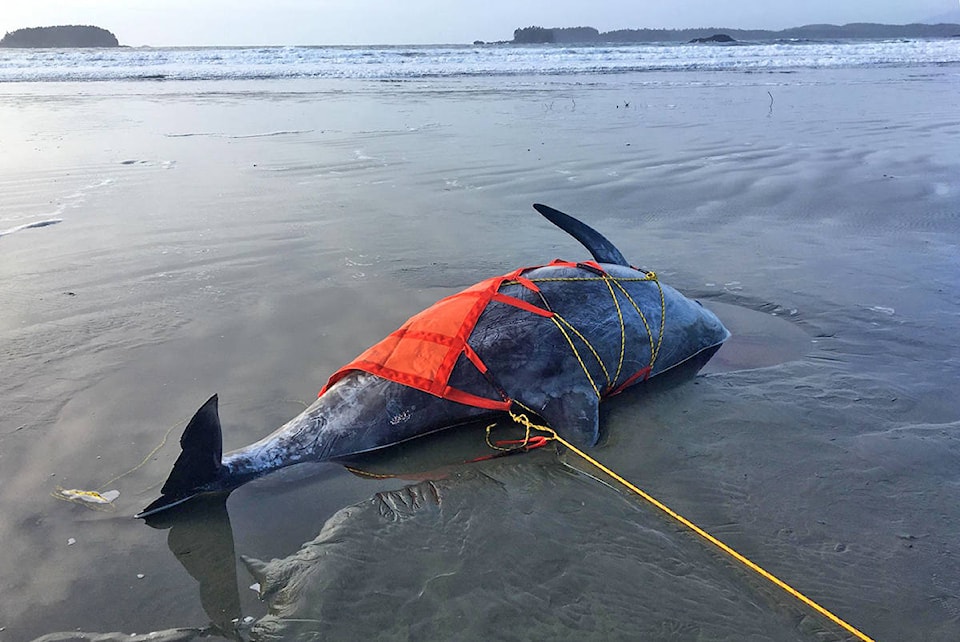A Risso’s dolphin was discovered washed up on a Tofino beach Wednesday morning.
Department of Fisheries and Oceans Canada spokesperson Lara Sloan told the Westerly News that the roughly three-metre long, 450-kilogram animal was reported around 9:30 a.m. and collected by DFO for necropsy. Its age and cause of death are not yet known.
Risso’s dolphins are abundant, but rarely seen because they hang out at the continental shelf roughly 40 miles from Tofino’s shoreline.
“In and of itself, it’s just a three-metre-long piece of slowly rotting marine mammal, but I get excited because it’s like a spaceship crashing to earth. When you get these offshore pelagic marine species getting washed up, it’s like Roswell, it’s like a UFO crash landed and you can come look at it,” Mark Maftei of the Raincoast Education Society told the Westerly on Thursday. “That for me is the exciting part, not specifically the Risso’s dolphin, just being reminded that not that far away is this whole other world.”
READ MORE: VIDEO: Ex-Canuck Willie Mitchell spots rare salmon shark off Tofino
He said relatively little is known about Risso’s dolphins, but their primary food source is squid that school at the continental shelf.
“It’s not until you get past that shelf that you really enter that whole new habitat…It’s a totally different ecosystem. If you go 40 miles offshore, you’re like on another planet out there and it’s a planet where animals like Risso’s dolphins are super common and albatrosses are everywhere,” Maftei said. “These things are here, they’re just not in the harbour. They’re a little ways out and if you go out there it’s pretty amazing to see that there is this whole other world…It’s a commitment to get out there. You’re totally exposed. You’re completely at the mercy of the weather and the winds and the seas. I don’t want to overstate it, but it’s not the kind of thing that you can just casually drive your boat 40 miles offshore the way you can casually jump in your car and drive 40 miles to Port. It’s not super easy, but it really is worth it.”
He added Risso’s dolphins usually travel in large groups sometimes in the hundreds or even thousands.
“If you were to spend a lot of time fishing offshore, you’d see Risso’s dolphins all the time. They dive down really deep, but they feed mostly at night so during the day they spend a lot of time near the surface and they’re quite active,” he said. “They’re pretty social and they travel around in big groups and I think that’s just a reflection of the fact that they’re not really competing with each other for limited resources.”
READ MORE: Dismal returns sound alarm over salmon crisis in Tofino and Ucluelet
Risso’s dolphins hang out so closely with each other that they’re consistently covered in scars.
“They’re really really scarred up. The one on the beach yesterday was a perfect example. It’s virtually impossible to find a Risso’s dolphin that’s not totally scarred up as if it went through a garburator…They’re not serious injuries and it’s not quite clear where those scars are coming from,” Maftei said. “The general consensus is that most of those scars are caused by other Risso’s dolphins, so they spend a lot of time tussling around. Whether that’s males and females competing for mates or whether it’s a sexual thing or a social thing…all Risso’s dolphins have them. They’re born smooth and then very quickly they start to get scarred up so, whatever it is, it’s something that affects all of them and that pattern is really unique.”
He said the species is widespread throughout the world’s oceans and enjoys healthy and abundant populations, though little research has been done on them.
He added that marine mammals like blue whales, sperm whales and minke whales are well documented because of past whaling activity, “so that knowledge has come at a cost,” while other species like gray whales, humpback whales and orcas spend a lot of time close to shore so are easier to investigate.
“Think about it land-wise. If you lived in the woods and you never went down to the beach, you’d know a lot about the creatures that live in the forest, bears and cougars and raccoons and squirrels and all the different trees, but you’d have no concept of all the animals that live at the beach,” he said. “There would be a whole group of animals that you would just never see if you never went into that habitat and there is almost as big a difference between the nearshore marine ecosystem and the offshore marine ecosystem.”
READ MORE: Tofino-Ucluelet region hops up to help frogs migrate under highway
He added that Wednesday’s washed up Risso’s dolphin provides an opportunity to learn more.
“When you get a really fresh, relatively new, undamaged specimen like that, there is a lot that you can get out of it, so that’s why DFO is usually pretty quick to grab them, cut them up, slice them and dice them and try to figure out as much as they can about that one individual animal. That gives you a better picture of what the whole species is up to,” he said.
andrew.bailey@westerlynews.ca
Like us on Facebook and follow us on Twitter
READ MORE: Surfer spots large shark off Wickaninnish Beach in the Pacific Rim National Park Reserve
READ MORE: Tofino mayor says rise in mass Velella velella strandings likely linked to climate change
READ MORE: Tofino played key role in inspirational dog’s journey
